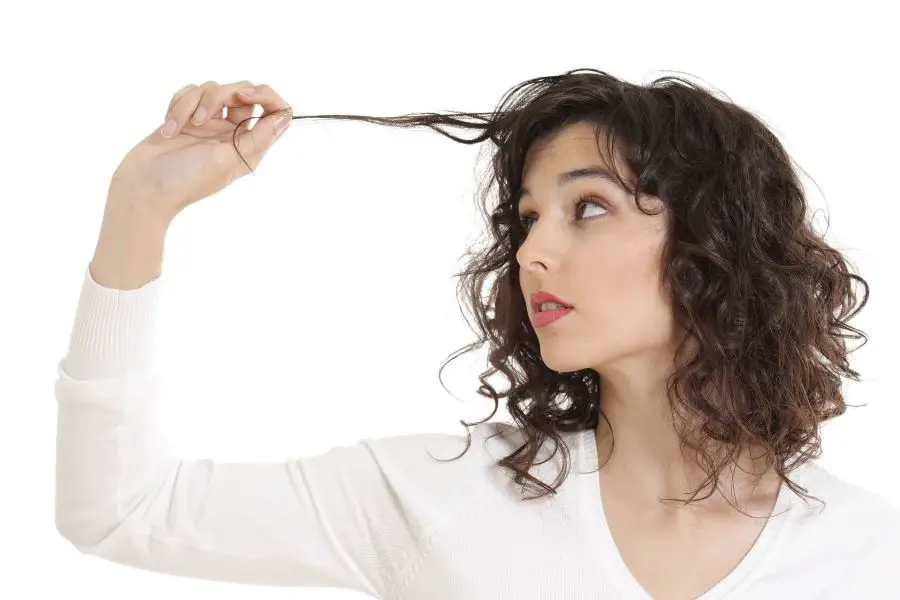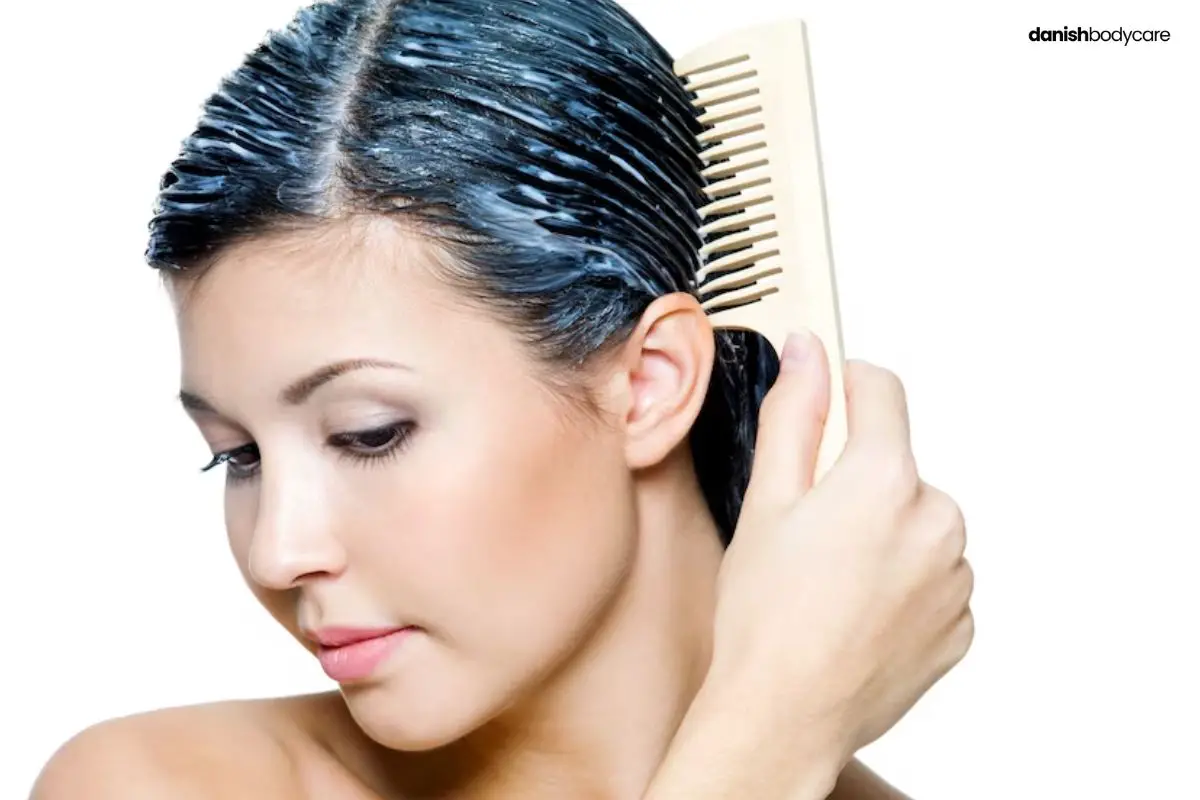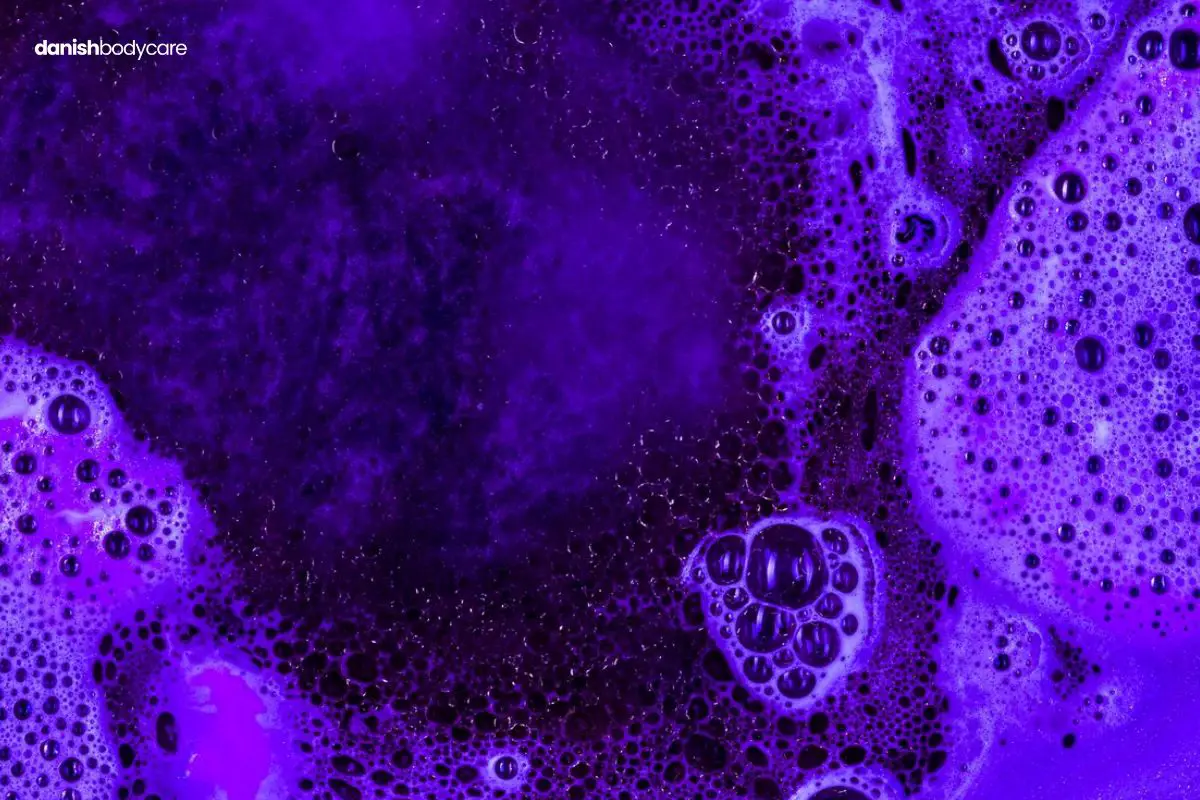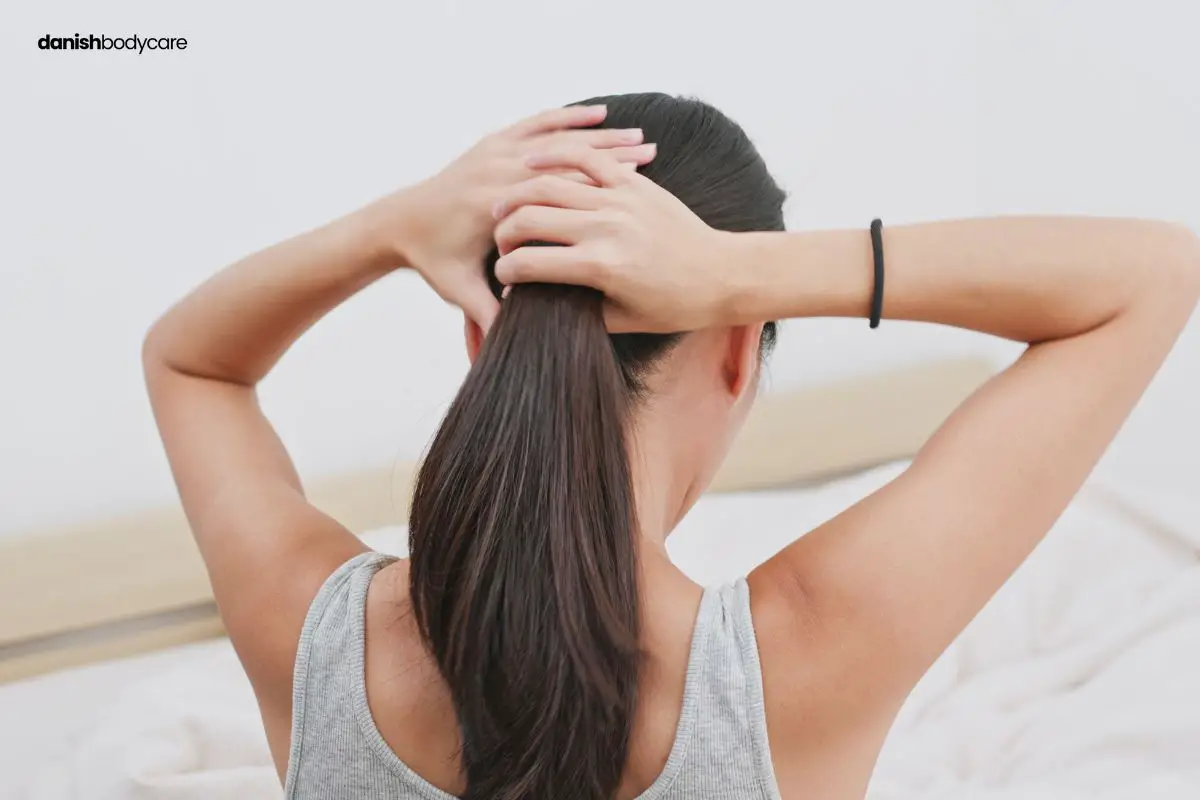If you’re thinking about bleaching your hair, prepare it first.
Bleaching can cause damage to your hair, but with the right preparation, you can minimize the risk.
For example, hair that has been chemically treated is more prone to damage during the bleaching process.
In this article, we’ll guide you through the steps to prep your hair for bleaching.
How to Prepare Hair for Bleaching

Do the following to prepare your hair for bleaching:
- Evaluate your hair type
- Evaluate your hair health
- Wait for damaged hair to heal
- Don’t use heat tools or chemical treatments a week before
- Moisturize
- Shampoo two days before, not right before
- Use hair oil before bleaching
- Deep conditioning before bleaching
- Choose the right bleach and developer
- Do a patch test
- Consult a professional
1. Evaluate Your Hair Type
Before you bleach your hair, determine your hair type: fine, medium, or coarse.
Your hair type will impact how bleach affects it. Fine hair bleaches faster, while coarse hair might need a stronger bleach solution.
2. Evaluate Your Hair Health
Check the health of your hair before you bleach.
If it’s dry, brittle, or damaged, avoid bleaching it. Bleaching can worsen the condition of your hair, so make sure it’s healthy before starting.
3. Wait for Damaged Hair to Heal
Delay your bleaching if you have damaged hair or had a chemical treatment within a week of bleaching. Give your hair time to heal to avoid further damage.
4. Don’t Use Heat Tools or Chemical Treatments a Week Before
Avoid using heat tools and chemical treatments (like perms or relaxers) a week before bleaching. This prevents excessive damage and ensures the bleach’s effectiveness.
5. Moisturize
Moisture protects your hair cuticle from bleach damage. Focus on moisturizing and conditioning your hair weeks before bleaching.
Use deep conditioning treatments to reinforce your hair’s strength.
6. Shampoo Two Days Before, Not Right Before
Wash your hair two days before bleaching, but not immediately before.
Your hair’s natural oils act as a protective barrier during the bleaching process. If you shampoo your hair before bleaching, you’ll remove the helpful oils.
7. Use Hair Oil Before Bleaching
Apply oils like coconut oil or argan oil to your hair before bleaching.
These oils function like your natural hair oils. They prevent extreme damage, as they penetrate and nourish your hair cuticle.
8. Deep Conditioning Before Bleaching
Deep condition your hair a week before bleaching to ensure that it’s well-moisturized. This decreases the chances of breakage and other damage.
9. Choose the Right Bleach and Developer
Select a bleach and developer suitable for your hair’s strength and texture:
- Volume 10 lifts your hair 1 shade. It’s good for thin and fine hair.
- Volume 20 changes your hair 1 to 2 shades. It’s good for thick hair.
- Volume 30 changes your hair color 3 to 4 shades.
- Don’t use Volume 40 developer.
Consulting a professional is a smart choice if you’re unsure which products to use.
10. Do a Patch Test
Perform a patch test before bleaching your entire head. Apply bleach to a small section of your hair to check for adverse reactions.
You can also do a strand test. Apply a little bleach to a strand of hair to see the expected result.
11. Consult a Professional
Speak with a professional to discuss your bleaching plan and any questions you have. Their expertise will ensure a safe and successful process.
Post-Bleaching Care

Take care of your hair after bleaching with these treatment methods:
- Use the right shampoo for blonde hair
- Don’t wash too often
- Co-washing
- Deep hair treatment for bleach-blonde hair
- Use a leave-in conditioner
- Use hair masks
- Use hair oil daily
- Use protein treatments
- Gentle brushing & detangling when wet
- Cut the damaged ends
- Reduce heat styling
Use the Right Shampoo for Blonde Hair
After bleaching your hair, use a shampoo made for blonde hair. Purple shampoo neutralizes brassy tones, keeping your blonde looking fresh and vibrant.
Don’t Wash too Often
To maintain your hair’s health, limit how often you wash it. Washing too often strips your hair of its natural oils. This leads to potential dryness and damage.
Aim for 2-3 times per week, depending on your hair type and needs.
Co-Washing
Co-washing is a technique that involves using only conditioner for cleansing. This method helps retain moisture in bleached hair, which prevents it from drying out.
Incorporate co-washing into your routine, alternating with regular shampooing.
Deep Hair Treatment for Bleach Blonde Hair
Deep treatments like hair masks are vital for bleached hair.
Once a week, use a moisturizing and nourishing hair mask to hydrate and maintain hair health. This will help repair and strengthen your hair over time.
Use a Leave-In Conditioner
Leave-in conditioners are excellent for detangling, protecting, and hydrating bleached hair.
Apply a small amount on damp hair after every wash. It’ll help with manageability and frizz reduction.
Use Hair Masks
To keep your bleached hair healthy, try using a hair mask that targets your specific needs.
For example, use a protein treatment to strengthen your hair or a moisture mask to hydrate it. This extra support helps maintain healthy hair between your weekly deep treatments.
Use Hair Oil Daily
Hair oils can keep your hair shiny and moisturized.
Use natural oils, such as argan, coconut, or almond, daily to help with frizz control and add softness to your hair.
Use Protein Treatments
Protein treatments prevent and repair bleach damage to the heair.
They strengthen and reconstruct your hair, restoring its health and resilience. Be cautious not to overuse protein treatments, as they can lead to brittleness.
Gentle Brushing & Detangling When Wet
Bleached hair is more prone to breakage, so be gentle when detangling.
Use a wide-tooth comb or a brush designed for wet hair. Brush from the bottom up to prevent unnecessary breakage.
Cut the Damaged Ends
After bleaching, your hair may have some split ends and damage. Regular trims will help maintain a healthier appearance and prevent further breakage.
Aim to trim your ends every 6-8 weeks.
Reduce Heat Styling
Limit your use of heat styling tools, such as flat irons and curling wands, when caring for bleached hair. The heat can further damage your hair.
Opt for heatless styling methods whenever possible.
Potential Bleaching Risks and How to Avoid Them
Bleaching your hair can be exciting, but it’s important to understand the potential risks and how to avoid them.
If you’re unsure about any part of the process, consult a professional hair stylist or colorist. They can guide you through the bleaching process.
Damage
One major risk is causing damage to your hair.
Bleaching can make your hair:
- Dry
- Brittle
- Frizzy-looking
- Prone to breakage
To minimize these risks, it’s necessary to take the right precautions.
Be cautious with the products you select for the bleaching process. Read the labels and follow the manufacturer’s instructions. This will help you stay safe and avoid any unwanted results.
Scalp Burns
Another risk when bleaching your hair is scalp burns. These can be painful and, in extreme cases, may even result in hair loss.
To avoid burns, always perform a patch test before applying bleach to your entire head. To do this, apply a small amount of bleach to a hidden patch on your scalp or skin to check for adverse reactions.
If there’s no irritation, you can continue with the bleaching process.
Proper Preparation to Avoid Bleaching Mistakes
Preparation is key when it comes to avoiding potential risks. Give your hair and scalp some extra TLC leading up to the bleaching process.
This includes conditioning treatments and avoiding heat styling tools. The healthier your hair is before bleaching, the lower the chances of causing damage.
Natural Alternatives for Lightening Hair
If you’re looking for natural ways to lighten your hair, here are some DIY alternatives:
- Lemon Juice and sun
- Chamomile tea and sun
- Raw honey
Lemon Juice & Sun
Lemon juice is a popular natural lightener due to its high citric acid content.
To use this method:
- Mix 1 cup of fresh lemon juice with 1/4 cup of water.
- Apply the mixture to your hair.
- Spend some time in the sun.
The combination of lemon juice and sunlight will gradually lighten your hair.
Keep in mind that lemon juice can be drying, so use a deep conditioner or hair mask afterwards to avoid brassy hair.
Chamomile Tea & Sun
Chamomile tea is another natural option for lightening hair:
- Brew a strong cup of chamomile tea and let it cool.
- Pour the tea into a spray bottle and mist it onto your hair.
- Spend time in the sun to enhance the lightening effect.
- After you’ve spent some time outdoors, rinse your hair.
- Apply a conditioner to keep it healthy and hydrated.
To avoid issues, take proper care of your hair, even when using chamomile instead of lemon juice. While chamomile is less likely to cause issues, it’s still important to be cautious.
Raw Honey
Raw honey is a natural ingredient known to lighten hair. Honey contains hydrogen peroxide, which can gradually lift your hair’s color.
To use this method:
- Mix equal parts raw honey and distilled water.
- Apply the mixture to your hair.
- Cover with a shower cap and let it sit for several hours or overnight.
- Rinse your hair and follow with a conditioner.
This home remedy may take some time to show noticeable results, but it’s a gentle and nourishing option for your hair.
Do’s and Don’ts Before Bleaching
- Do a strand test to check if your hair can handle the bleach.
- Do skip shampoo for a day or two before bleaching.
- Do use a deep conditioning treatment a few days before bleaching.
- Do follow the instructions on the product.
- Do wear gloves and use a plastic or glass bowl for mixing the bleach.
- Don’t use a metal bowl, as it can react with the bleach.
- Don’t wash your hair right before bleaching it.
- Don’t rush the process.
Frequently Asked Questions
Should I deep condition my hair before bleaching?
Yes, you should deep condition your hair before bleaching. It moisturizes and strengthens your hair, preventing excessive damage during the bleaching process. Do this a few days before bleaching, as over-moisturized hair can interfere with the bleach.
Can I bleach my hair a day after washing it?
It’s better to wait at least two days after washing your hair before bleaching. Doing this allows your hair’s natural oils to build up, providing extra protection. This makes the bleaching process more effective.
Do I shampoo after bleach?
Yes, you should shampoo your hair after bleaching to remove any remaining bleach and debris. Use a gentle, sulfate-free shampoo to avoid further damaging your hair.
Should I oil my hair before bleaching?
Apply a light oil, such as coconut or argan oil, on your hair before bleaching. This creates a protective barrier and reduces the potential damage caused by bleach. Heavy oils can interfere with bleach’s effectiveness, so use a small amount and distribute it.
Best hair mask to use before bleaching
Look for a hair mask with moisturizing and repairing ingredients, such as keratin or argan oil. A hair mask a few days before bleaching prepares your hair for the process.
Leave-in conditioner before bleaching
Leave-in conditioner before bleaching is not recommended. It may interfere with the bleach’s effectiveness. You should use a leave-in conditioner after bleaching to help restore moisture and manageability to your hair.
What can I add to bleach to protect hair?
You can add a bond-strengthening additive like Olaplex to your bleach mixture. It minimizes damage and breakage during the bleaching process by protecting your hair’s protein bonds.
Can hair be too greasy to bleach?
Greasy hair may not bleach evenly or could protect the hair too much, leading to an undesired outcome. In such a case, it’s better to wash your hair a day or two before bleaching.
What not to do before bleaching hair?
Avoid chemical treatments, heat-styling, or heavy hair products before bleaching. These actions can cause damage and create an uneven bleach outcome.
Is it OK to have dirty hair before bleaching?
It’s beneficial to have slightly dirty hair before bleaching, as the natural oils provide protection. Hair that is too dirty or greasy can pose problems. Make sure to strike a balance by avoiding washing your hair for a day or two before the bleaching process.








